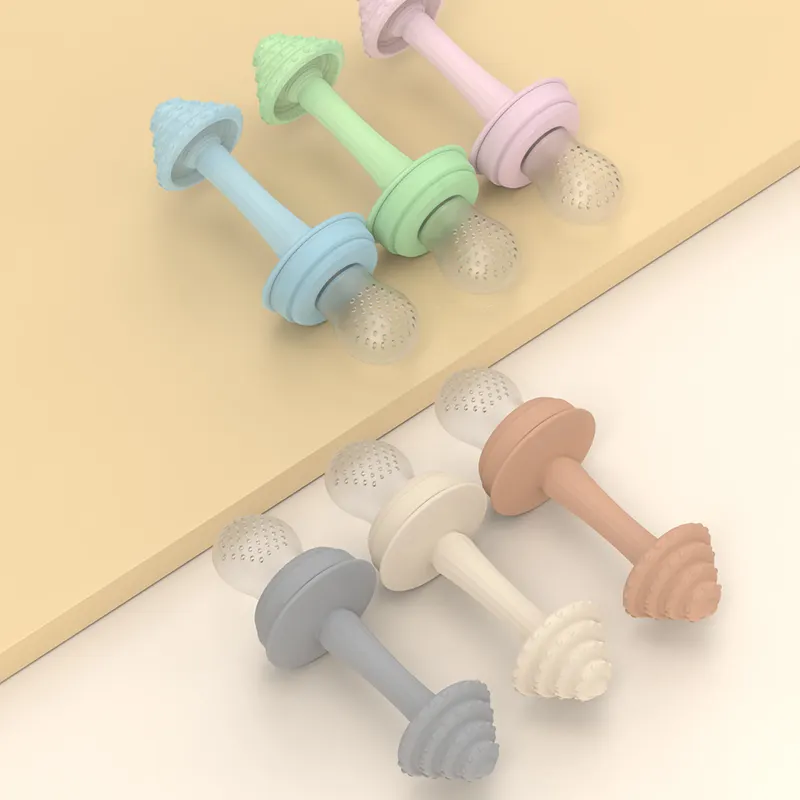הבנת מזונות פירות לתינוקות שקורעים שיניים
מהו מזון פירות?
א מזין פירות הוא כלי שפותח במיוחד לתינוקות, ומאפשר להם לצרוך פירות בצורה בטוחה ולמזער סיכונים של 질יקה. לרוב, יש שני דגמים עיקריים של מנקשים: שקיות סריג ואגרטנים מסיליקון, ששניהם מאפשרים לתינוק ללעוס ולגשת לעסיסים מבלי לבלוע חתיכות גדולות שעלולות להוות סיכון. בהקשר של הקניית מזונות מוצקים, מנקשי פירות הופכים לפופולריים במיוחד בתקופות גידול השיניים. רופאי ילדים ממליצים לרוב על מנקשי פירות ככלי מעבר להכרת טעמים ומגוון משTextures בדרכים מאובטחות, ובעזרתם התינוק יכול לחוות טריפ מזון שונה, וכן לקבל הקלה בתהליך גידול השיניים.
איך פועלים מנקשי פירות?
תומכי פירות בנהדרת בדרכים שונות לעזור לתינוקות ליהנות מטעמים ומרקמים של פירות באופן בטוח. המנגנון של מנקדים אלו פשוט אך יעיל - תינוקות נושכים את המנקד כדי לספוג מיץ וחתיכות קטנות של פרי, כשלنفس זמן העיצוב שלו מונע סכנת 질יקה. כדי להשתמש במנקד פירות, ההורים יכולים למלא אותו בפירות רכים כמו בננות, אפרסקים או ענבים, שנחשבים לבחירת האידיאלית. השימוש הפשוט והקל מאפשר להורים להגיש פירות ללא צורך בשגירה מתמדת, ובכך מקטין משמעותית את הסיכון לבליעה לא מבוקרת. בת testimonials של הורים רבים מודגשת הפשטות והיעילות של מנקדי פירות, וכיצד כלים אלו תומכים בטיפוח הבטחה באכילה ובעודד גילוי טרומי אצל הילד.
מרגיע חניכיים קשות באופן טבעי
שימוש במַאֲכִיל פֵּרוֹת יָכוֹל לְהָבִיא הֶרֶף מְנוּחָה לַעֲגוֹלוֹת שֶׁחוֹוֶה מִתַּסְבֵּךְ. הַמַּעֲשֶׂה שֶׁל הַנְּשִׁיכָה בַּמַּאֲכִיל אֵינוֹ נָח לַעֲגוֹלָה בִּלְתִּי, אֶלָּא שֶׁהוּא גַּם מְעַזֵּר לְהָרִים אֶת הַכְּאֵב עַל־יְדֵי הַשְׁמוֹט כּוֹפֵף קַל עַל הַלֵּבִים הַמְּחוּלָּשִׁים. לְבַד מִזֶּה, פֵּרוֹת קְרוּרִים יְכוֹלִים לְהִישָּׂם בַּמַּאֲכִיל, וּלְהָבִיא הֶרֶף רִפּוּד עַדִּיר, מַה שֶּׁעוֹשֶׂה אוֹתוֹ לְבַחִירָה מְדוּפְּסֶתֶת בֵּין הַהוֹרִים הָרַבִּים. עֵדוּת אוֹתִיּוֹת מֵאֲבוֹת וְאִמָּאוֹת מַרְבּוֹת מַרְאִין כֵּיצַד מַאֲכִילֵי פֵּרוֹת הִפְחִיתוּ בְּצָלוֹת בְּמַחֲווֹת הַתַּסְבֵּךְ, וְהֵבִיאוּ נַחֲמָה חֲשׁוּבָה לְטוֹפֵיהֶן.
בִּלְתִּי BPA סִיליקוֹן
בעת בחירת מזון לפירות, יש להעדיף חומרים שמאוחסנים ללא BPA, כמו סיליקון. BPA (ביספנול A) הוא חומר כימי שנמצא לרוב בפלסטיק, וחשיפה אליו עשויה להוות סיכון בריאותי לתינוקות, כפי שמפורט בדוחות של ה-FDA. לכן, בחירת מזונות שמיוצרים מחומרים ללא BPA תבטיח הגנה מפני חומרים potentially מזיקים לתינוקכם. מומלץ להורים לחפש תעודות תאימות או סימני בטחה על גבי מוצר המזון. פעולה זו תחזק את האמון ותבטיח שהמזון שבחרתם הוא בטוח, ותאפשר לכם נחת כאשר הילד שלכם נהנה מהרפיון השיניים שלו.
חסרונות פוטנציאליים של מזונות לפירות
סיכונים עקב חשיפה מוגבלת לטקסטורות
בעוד מקלות לפירות מציעים דרך נוחה ובטוחה לתינוקות לחקור טעמים חדשים, העיצוב שלהם מגביל באופן טבעי את החשיפה למגוון טקסטורות של אוכל. הבנייה מהמסך או הסיליקון מספקת טקסטורה אחידה שאינה מייצגת בצורה מלאה את התחושות המגוונות של המזונות האמיתיים, אשר חיוניות להתפתחות כישורי הקדיח. לפי מחקרים בתזונה ילדית, הקדמה של טקסטורות שונות לתינוקות עוזרת בפיתוח הביטחון והיכולת להתמודד עם מגוון צורות מזון. כדי להבטיח חוויית חושים מאוזנת, אני ממליץ לכלול מזונות מוצקים יחד עם השימוש במקלות לפירות. מתן טווח של טקסטורות מאפשר לילדים ללמוד את הדגשים של קדיח ובליעה, ותרומה חיובית להתפתחות האכילה הכללית שלהם.
קשיים בتنظيف
שמירה על ניקיון מנקיות פירות יכולה להיות אתגר, במיוחד כשמדובר בדגמים עם עיצובים מורכבים שעלולים לאגור שאריות אוכל. שמירה על היגיינה היא חיונית לא רק לפקוליאות המנקייה אלא גם למניעת גידול חיידקים שעלול להיווצר עקב ניקיון לקוי. שימוש במנקיית פירות שניתן לשטוף במכלת כלים או בתחליבי צינורות מיוחדים יסייעו בניקיון מעמיק ויענו בצורה יעילה על האתגרים הללו. מומחים מדגישים את חשיבות הניקיון השגרתי והקפדן כדי למנוע הצטברות חיידקים שעלולה לפגוע בבריאות ובבטיחות התינוק. ההורים חייבים לשמור על זהירות רבה בנהלי הניקיון שלהם כדי להבטיח חוויית אכילה בטוחה ליולדם הקטן.
הנחיות שימוש בטוח במנקיית פירות
הכנה מתאימה של המזון
שמירה על שימוש בטוח במזונות פירות מתחילה בהכנה נכונה של המזון. פירות רכים ומבשילים הם אידיאליים לתינוקות שמרutschים שיניים, ומציעים טעם וקלות בליעה. חשוב להורים להכיר את מידות החלקים כדי לצמצם את סיכן החניקה. המלצות מעשיות כוללות חיתוך הפירות לקטעים קטנים שאותם יוכל התינוק להחזיק ולבלוע בצורה בטוחה. בנוסף, הסרת זרעים או קליפות קשות מהפירות לפני הצבתם במזונת הפירות היא הכרחית כדי למנוע סיכונים. עמידה בהנחיות ההכנה הללו תאפשר לתינוקות הקטנים שלנו לחוות אינטראקציה בטוחה ונהנה עם מזונות הפירות.
עקרונות מומלצים לפיקוח
לא ניתן להדגיש מספיק את חשיבות הפקחת על תינוקות בזמן שהם משתמשים במזונות פירות. מעקב זה מבטיח צריכה בטוחה ומאפשר להורים לנקוט בפעולה מיידית במקרה של בעיות. השתתפות ההורים היא קריטית במיוחד בעת הצגת מזונות חדשים שעלולים לעורר תגובות אלרגיות או לגרום לדלקות. שמירה על עין על האינטראקציה של התינוק עם המזון יכולה למנוע שימוש לא נכון, כמו ניסיונות לבלוע את המזון עצמו. כאשר הם חוקרים טעמים ומגוון משטחי מרקם, הפקחת שלנו פועלת כרשת ביטחון, ומבטיחה לנו שהם מתנסים במאכליים בצורה בטוחה. באמצעות השמירה על ראייה שיקטה, אנו לא רק מגנים עליהם מפני סיכונים פוטנציאליים אלא גם מעודדים חוויות חיוביות אשר יבנו את ביטחונם בעניין צרכון מגוון מזונות.

אופציות נוספות לפתרון כאבי גידול שיניים
מזונות סיליקון קרים
מקררים סיליקוניים הם חלופה מצוינת remedy לטיפול בטנה ומסייעים להרגיע לחיים כואבות. בניגוד למפרישי פירות, מקררים אלו אינם דורשים הכנת אוכל וניתן לקרר אותם בקלות כדי לספק הקלה מיידית לתינוקות בטנים. למרות ששני המפרישים והמקררים מציעים נוחות, יש הבדלים בישום שלהם; מקררים מסתמכים על טמפרטורה לצורך הרוגע, בעוד מפרישים משתמשים בטקסטורת האוכל. גמישות זו בעיצובים של הסיליקון מבטיחה שהתינוקות יוכלו לתפוס ולשמור עליהם ביתר קלות, לקדם שימוש עצמאי ולקטין את תחושת הדחף במהלך פרקי הטנה. עם אחיזה נוחה, מקררים אלו לא רק שמייצרים נוחות אלא גם תורמים להתפתחות הכישורים המוטוריים.
מפרישי פירות ברשת קרים
מַאֲכִילֵי פֶּרֶק בְּתוֹרַת מָרוֹב מְצַפִּים תָּפוּק כְּשֶׁלוֹחֲמִים אֶת הַפֵּרוֹת עִם הַהֶפְשֵׁט הַמְנַחֵם שֶׁל חֳפָצִים קָרִים, וְעַל כֵּן הֵם נֶחֱרָרִים לְמוֹנְעֵי סִדְרוּת. הַמְּאָכִילִים הָאֵלּוּ יְכוֹלִים לְהִמָּלֵא בְּפֻרְמָה, שֶׁאֵינָהּ רַק מְנַחֶמֶת אֶת הַלָּשִׁין אֶלָּא גַּם מוֹסֶרֶת טֶקְסְטוּרוֹת מְגוּוָנוֹת שֶׁאֵינָן קַיָּמוֹת בְּמַאֲכִילֵי פֵּרוֹת מְסוֹרְתִּיִּים. נִיסְיוֹן עִם מְלִיאוֹת שׁוֹנוֹת יְכוֹלָה לְהַפְכוֹר אֶת חוּווַת הַהַאֲכָלָה, וּלְהַעֲבִיר חוּוִית חִוּוִיִּים יְחוּדִּיִּים לַיְלָדִים. הַהוֹרִים יְכוֹלִים לְהִנְהֵן מִגִּישָׁה זוֹ וּלְהִנְהֵן מִנְּקִיָּה קַלָּה וּמְהִירָה שֶׁלָּהֶם בַּעֲבוּר הֶעָרְכָּה הַיְשֵׁרָה שֶׁל מַאֲכִילֵי הַמָּרוֹב. מֵאַחַר שֶׁהַמְּאָכִילִים הָאֵלּוּ מְשַׁבְּעִים גַּם צָרְכֵי תַזּוּנָה וְגַם הֶפְשֵׁט מִסִּדְרוּת, הֵם מְשָׁרְתִים כִּכְלִי רַב-תָּפוּק לַהוֹרִים שֶׁמְּבַקְשִׁים פִּתְרוֹנוֹת חוֹדוּרִיּוֹת.
פִּתְרוֹן דְּאָגָאוֹת הוֹרִים בְּנִיגוּד לַמְּאָכִילִים
מניעת סיכון לחניקה
מַאֲכִילֵי פֵּרוֹת נִבְנוּ עִם תְּכָנִים מִשְׁמָרִים מְסוּיָּמִים שֶׁמַּפְחִיתִים אֶת סַכָּנַת הַחֲנִיקָה, שֶׁהִיא אַחַת הַדְּאָגוֹת הָעִיקְרִיוֹת שֶׁל הֵורִים. רַבִּים מֵהַמַּאֲכִילִים בָּאִים עִם מְכָנִזְמֵי נְעִילָה בְּטִיחִים וּפְתָחִים דַּקִּים שֶׁמֵּבִיאִים לְבִרּוּר שֶׁרַק פֵּרוֹת מְמוּסִים עוֹבְרִים דָּרֶכְהֶם, וּבְזֶה מְחַשְׁפִּים אֶת הַסַּכָּנוֹת. לְמִשְׁמַר הַבְּטָחָה, חַיּוּב לִלְמֹד אוֹתָן שִׂיטוֹת אִכִּילָה בְּטִיחוֹת וּלְבַחֵר בְּפֵרוֹת שֶׁהֵם מֻתְאָמִים לְגִילָּם שֶׁל הַיְלָדִים. הֵורִים יֵצְאוּ בְּפֵרוֹת רַכּוֹת כְּמוֹ בַּנָּנָה אוֹ אָבוֹקָדוֹ וְיִמְנְעוּ מֵהַשְׁתַּמְּשׁוּת בְּפֵרוֹת קָשִׁים יוֹתֵר אוֹ בְּאֵלוּ שֶׁיֵּשׁ לָהֶם זֵרוֹעִים. בְּדִירָאוֹת מִצַּד הֵורִים נִרְאָה רֹבְדָה גְּדוֹלָה, וְהֵם מְפָאֲרִים אֶת הַמַּאֲכִילִים בְּשֶׁהֵם מְבִיאִים לְשַׁלוֹם הַנֶּפֶשׁ שֶׁלָּהֶם עַל יְדֵי הֲפָחַת סַכְנַת הַחֲנִיקָה, בְּהֶפְשָׁרַת הַתִּינֹקוֹת לֶאֱכוֹל פֵּרוֹת מְזוֹנִים בְּאָמְנֻתּוּת.
מתי להפסיק את השימוש
קביעת הרגע להפסיק להשתמש במזונות פירות דורשת תצפית בסימני התפתחות של הילד. כאשר תינוקות מתחילים להפגין סימנים של מוכנות למאכל מוצק, כמו יכולת greater ללעוס ולבחון עניין באכילה עצמית, ההורים יכולים לשקול לעבור ממתקי המאכל. זיהוי סימנים אלו הוא הכרח לפיתוח עצמאות באכילה, צעד חשוב בהתפתחות הילד. לייעוץ אישי, מומלץ להתייעץ עם רופאי ילדים, אשר יוכלו להציע הדרכה מותאמת לשכבת גיל מסוימת. המטרה היא לאפשר מעבר חלק מתלות במזונות פירות לעידוד טקסטורות מאכל מורכבות.
שאלות נפוצות
מהן ההטבות בשימוש במזונות פירות לתינוקות בהלחייה?
מזונות פירות מספקים דרך בטוחה לתינוקות לחוות טעמים, מצילים מהלם הלחייה, ומנעים סיכונים של חניקה בשל עיצובם. הם גם עוזרים לתינוקות לעבור למאכל מוצק.
האם מזונות פירות קלים לניקוי?
מקשה על ניקיון של מזונות פירות, במיוחד אם הם בעלי עיצובים מורכבים. שימוש בדגמים המותאמים למכונת כלים וברשתות לנקז בקבוקונים עוזרים להבטיח היגיינה מתאימה.
אילו פירות מתאימים ביותר למזונות פירות?
פירות רכים כמו בננות, אפרסקים וענבים הם האידיאליים למזונות פירות. פירות קרים יכולים לספק נחמה נוספת ללחיוך חם.
כמה זמן ילדי צריך להשתמש במאכל פירות?
השימוש תלוי בהתפתחות הפרט. ברגע שהתינוק מפגין מוכנות לאכילה מוצקה וליכולת ללעוס, הגיע הזמן לשקול להכניס טקסטורות מורכבות יותר.
האם יש סיכונים הקשורים למזונות פירות?
למרות שהם בטוחים בדרך כלל, סיכונים כוללים חשיפה מצומצמת לטקסטורות וקושי בניקיון. פיקוח על התינוק ושימור תactices ניקיון מתאימות יכולות לעזור בהפחתת הסיכונים.

